
UTES are the tow tugs of choice for many travellers so we’ve grabbed six of Australia’s most popular utes and hitched each of them to a near three-tonne caravan for testing.
This article was originally published in the Utes 2016 issue of 4X4 Australia.
We had most of the heavy-hitters in the 4x4 ute category: the Ford Ranger, Isuzu D-MAX, Mazda BT-50, Mitsubishi Triton, Nissan Navara ST-X and the Toyota Hilux SR5. All were autos (the choice for heavy towing) and all but the BT-50 were dual cabs; Mazda supplied a Freestyle extra cab for this test. Mechanically identical to the dual-cab, the minor weight change will make no difference to the Mazda’s performance.
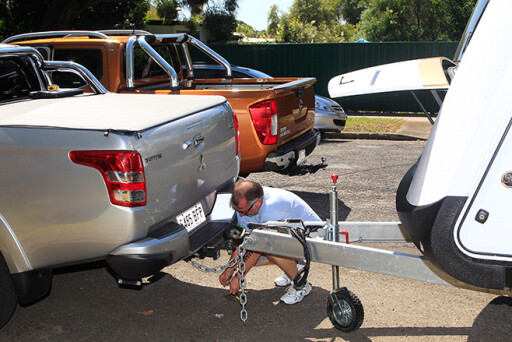 All the utes here had an after-market electric brake controller except Mazda,which offers a brake controller as an approved accessory.
All the utes here had an after-market electric brake controller except Mazda,which offers a brake controller as an approved accessory.
Unfortunately, missing from the action were two other popular utes: Holden Colorado and Volkswagen Amarok. Holden had no Colorados on fleet with a towbar and electric brake controller and Volkswagen will not fit an EBC (necessary to lug an electric-braked trailer such as our 2.8-tonne caravan) to any of its press/media vehicles due to its global policy of not fitting non-genuine accessories.
Buyers' guides: 4x4 gear
WHAT WE DID
The test route was a varied 200km loop south out of Sydney, with the kays chewed up in city traffic, two-lane highways and freeways. There were plenty of steep climbs and descents, some broken road surfaces and winding secondary roads.
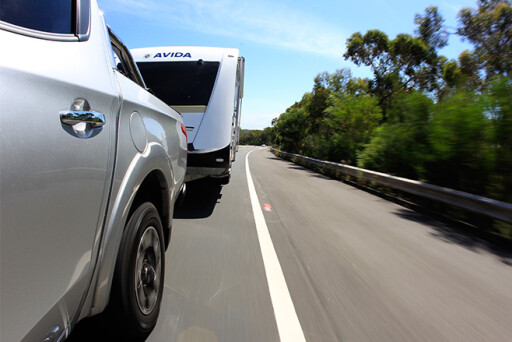 As well as general feel for the road, we performance tested against the clock. We also measured what speed the utes could hold hauling the van uphill and how well engine braking coped heading downhill. Accurate timing was provided by a Drift Box (as used by our colleagues at MOTOR and Wheels magazines for testing new cars) for standing-start and roll-on acceleration times.
As well as general feel for the road, we performance tested against the clock. We also measured what speed the utes could hold hauling the van uphill and how well engine braking coped heading downhill. Accurate timing was provided by a Drift Box (as used by our colleagues at MOTOR and Wheels magazines for testing new cars) for standing-start and roll-on acceleration times.
Fuel use was also measured. We cruised at a maximum of 100km/h, as required by NSW law when towing with a Gross Combined Mass (GCM) of more than 4500kg. With the test route’s hilly terrain, performance testing and the needs for photography, our fuel consumption should be taken as a worst-case scenario: In other words, you will use far less fuel!
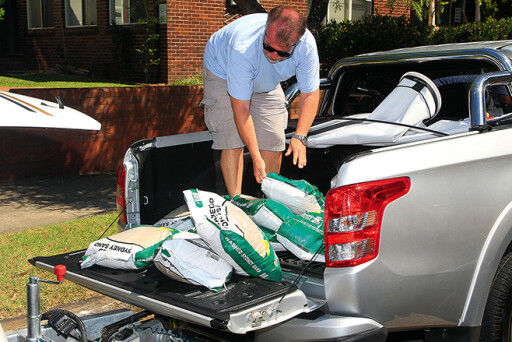 We tested two-up with 160kg of sand in each tray to replicate a typical holiday load. A Hayman-Reese break-away brakes remote battery monitor was plugged into a 12V accessory port to wirelessly monitor the caravan’s on-board break-away battery; again as required by NSW law.
We tested two-up with 160kg of sand in each tray to replicate a typical holiday load. A Hayman-Reese break-away brakes remote battery monitor was plugged into a 12V accessory port to wirelessly monitor the caravan’s on-board break-away battery; again as required by NSW law.
Add-on towing mirrors are either door-mounted (the trucker style mirrors) or mirror-mounted. We used the Ora Rossa mirror-mounted units with Ora’s optional magnetic door-mounted bracing.
Let’s hitch up and go!
FORD RANGER WILDTRAK
 The Ranger gets down to business with its equal-best (with the Mazda BT-50) engine power and torque making relatively light work of pulling the van. On the road, the Ranger is one of the more relaxed and quiet tow tugs at a steady cruise, although the inline five lets you know when it is working hard. The six-speed trans seems to have a big ratio gap between the crucial second and third gear change and it takes a while to up-shift after a hill climb levels onto flat terrain.
The Ranger gets down to business with its equal-best (with the Mazda BT-50) engine power and torque making relatively light work of pulling the van. On the road, the Ranger is one of the more relaxed and quiet tow tugs at a steady cruise, although the inline five lets you know when it is working hard. The six-speed trans seems to have a big ratio gap between the crucial second and third gear change and it takes a while to up-shift after a hill climb levels onto flat terrain.
Using the sport mode makes the Ranger more eager to shift down, but it also holds gears after the extra revs are needed. The manual mode works best, including for engine braking; the transmission has a predictive mode that downshifts when it senses it is necessary (which works well when not towing) but it doesn’t downshift to a low enough gear when there’s something weighty on the towball.
The Ford has the equal-longest wheelbase (again with the BT-50) at 3220mm and shortest rear axle-to-towball stretch of 1330mm to provide a good foundation for stable towing. Also encouraging was the lack of front body rise with the bags of sand on board and the van hitched up; just 10mm. Rear suspension compression was more significant; the biggest droop in the group of 80mm.
The Ford is one of the most stable vehicles here; little affected by crosswinds, large trucks (with their destabilising bow wave of air) or yaw (sway) when changing direction or braking. Body pitching is minimal and the Ranger rode smoothly with the big box on the tail. The Ranger also was quickest accelerating, except in the 50-70km/h increment, where it was matched by the BT-50.
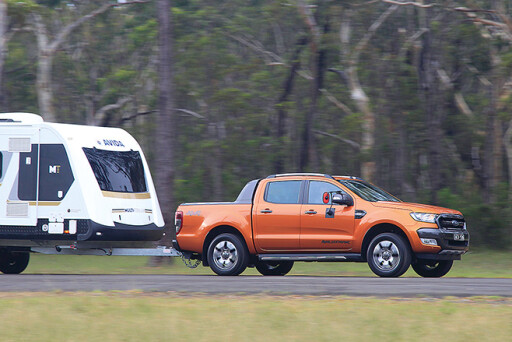 The Ranger’s reversing camera screen incorporates a centre-line marker to help line up the towball, and it works really well. Helping ease sway anxiety is the Ranger’s standard trailer sway control, although we never had the need to rely on its help. Making life easier for those who need to power accessories in their caravan, the Ranger comes standard with a 12-pin plug.
The Ranger’s reversing camera screen incorporates a centre-line marker to help line up the towball, and it works really well. Helping ease sway anxiety is the Ranger’s standard trailer sway control, although we never had the need to rely on its help. Making life easier for those who need to power accessories in their caravan, the Ranger comes standard with a 12-pin plug.
The Ranger’s side mirror casings had a lot of flex in them around the lip where the towing mirrors brackets were secured. This meant the towing mirrors vibrated a lot, making them hard to use at speed however permanent-fit truck-style towing mirrors would of course fix this.
SPECS
Engine: 3.2-litre 5cyl turbodiesel
Outputs: 147kW at 3000rpm/470Nm at 1500-2750rpm
Transmission: Six-speed auto with manual mode
Driveline: Part-time 4WD with high/low range
Weight: 2137kg
Max towing capacity: 750kg (unbraked) 3500kg (braked)
Max towball download: 350kg
Fuel tank capacity: 80 litres
Price as tested: $57,890 (not incl on-road costs)
TOW TEST RESULTS
0-60km/h: 11.2sec
0-80km/h: 19.6sec
50-70km/h: 7.5sec
Hillclimb speed (start 100km/h): 73km/h
Descent speed (start 80km/h): 89km/h
Test average fuel consumption: 20.6L/100km
Towing range: (with 50km safety margin) 330km
WHAT WE RECKON
The Ranger is a terrific tow rig and it shoulders a load without much fuss. Taking into consideration factors such as acceleration (an important consideration when sharing the road) economy and driver comfort (good for reducing stress levels encountered when towing) the Ranger is the best heavy hauler of this bunch.
MAZDA BT-50 FREESTYLE
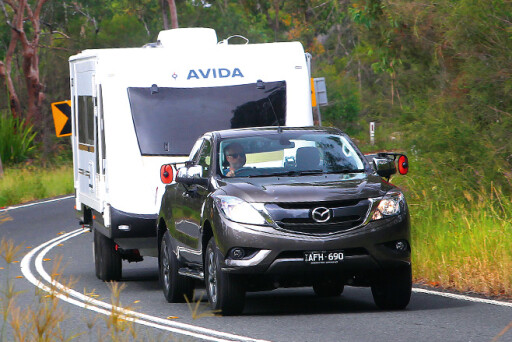 With a powertrain and chassis very similar to the Ford (there engine hardware differences) the Mazda offers similar performance as a tow vehicle. Our test Mazda was a Freestyle extended cab, not a dual cab like the others, but this didn’t affect dynamics.
With a powertrain and chassis very similar to the Ford (there engine hardware differences) the Mazda offers similar performance as a tow vehicle. Our test Mazda was a Freestyle extended cab, not a dual cab like the others, but this didn’t affect dynamics.
Like the Ranger, the Mazda BT-50 has a 12-pin trailer plug as standard. The Mazda has a rear-view camera display within its rear-vision mirror and, like the Ford, it has a black line marker to assist coupling up a trailer. The BT-50’s side mirrors are an awkward shape for clipping on the towing mirrors but held them tight with very little vibration.
The BT-50 isn’t quite as relaxed as the Ranger when touring, seeming more keen to pick up a lower gear than the Ford. Perhaps this is due to the Mazda’s different engine tuning, which sees it with a narrower torque band than the Ranger. The inline five-cylinder diesel is just as vocal as the Ranger’s when called upon for power or engine braking in the hills.
The BT-50, with an average of 20.88L/100km, was in the middle of the fuel consumption ranking; very close to the Ford. The transmission is less inclined to hold lower gears after the need has passed than the Ranger. Like Ranger, the lower ratios in the six-speed auto are spaced a little too far apart.
Like others, the Mazda’s sport mode doesn’t work so well with such a heavy caravan behind. You need to be more proactive with downshifts for engine braking, in particular. When hill climbing, the Mazda holds onto a taller gear when it would benefit from selecting a lower gear which you have to do manually.
The BT-50 (together with the Ranger) has the longest wheelbase at 3220mm, but its rear axle-to-towball measurement was the second longest, at 1420mm. The front ride height increased just 15mm, while the rear hunkered down by 35mm.
 The BT-50 feels rock-solid on the road, with even less pitching than the Ranger and not much sway at all. We had the occasional wriggle as a B-double thundered past, but that was it. The BT-50 has trailer sway control as part of its stability control system but we didn’t have it kick-in.
The BT-50 feels rock-solid on the road, with even less pitching than the Ranger and not much sway at all. We had the occasional wriggle as a B-double thundered past, but that was it. The BT-50 has trailer sway control as part of its stability control system but we didn’t have it kick-in.
The BT-50 was one of the better towing performers when asked to dig deep, clocking the fastest zero to 60km/h time, and either equalling or just trailing the Ranger in all other performance measurements. All in all, it’s a stout towing performer.
SPECS
Engine: 3.2-litre 5cyl turbodiesel
Outputs: 147kW at 3000rpm/470Nm at 1750-2500rpm
Transmission: Six-speed auto with Sport and Manual mode
Driveline: Part-time 4WD with high/low range
Weight: 2005kg
Max towing capacity: 750kg (unbraked) 3500kg (braked)
Max towball download: 350kg
Fuel tank capacity: 80 litres
Price as tested: $49,675 (not incl on-road costs)
TOW TEST RESULTS
0-60km/h: 10.9sec
0-80km/h: 19.9sec
50-70km/h: 7.5sec
Hillclimb speed (start 100km/h): 75km/h
Descent speed (start 80km/h): 87km/h
Test average fuel consumption: 20.9L/100km
Towing range: (with 50km safety margin) 333km
WHAT WE RECKON
The Mazda’s all-round competence when towing is almost a tie with the Ford, so in this competition it’s a solid silver medal. Recent updates to Ranger means it’s moved forward in real-world performance but the Mazda continues to hold a general price advantage. Yep, this is a very sensible tow car purchase
TOYOTA HILUX SR5
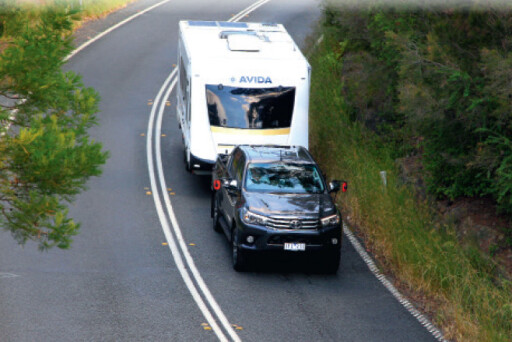 The Hilux was a surprise package as a tow tug. It likes a drink and isn’t the fastest of the lot, but it’s a relaxed and comfortable heavy-load hauler.
The Hilux was a surprise package as a tow tug. It likes a drink and isn’t the fastest of the lot, but it’s a relaxed and comfortable heavy-load hauler.
Trailer sway control is included in the Hilux’s chassis electronics safety armoury and the Toyota Accessory towbar comes with a seven-pin plug to suit most small-to-middling trailers. The reversing camera screen looks the goods with a blue centre line marking the spot where you should line up the coupling. The problem was (like all Toyotas we’ve tested recently with this feature) the line is about 100mm out. The Hilux’s side mirrors might look sexy but it’s awkward to get towing mirrors onto them. Once we got the mirrors on, they are held firm and only shake a little at speed.
On the road, the Hilux is the most relaxed, quiet performer of the bunch when settling into an easy cruise, and is the quickest to get off the mark, although it doesn’t keep up the good work beyond that. Even when heading for the hills and working the 2.8-litre diesel hard, it doesn’t intrude too much with shimmy or sound and remains smooth spinning up around 3500rpm. The only downside is that the Hilux sucks down more distillate than the others here, just pipping the Mitsubishi Triton with a figure of 22.4L/100km.
The Toyota’s six-speed auto has a power mode and a manual mode. It does work better in the Power mode when towing, but benefits from driver’s manual intervention for anticipating steep climbs or descents.
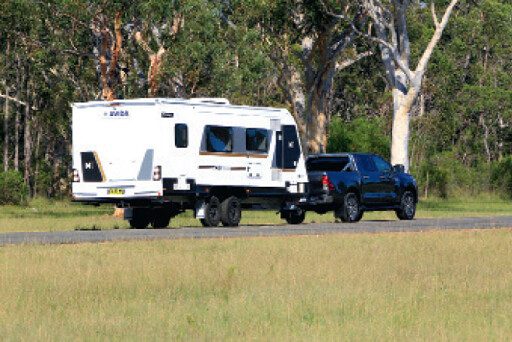 With a 3085mm wheelbase and a 1360mm distance from the axle line to the towball, the Hilux has the on-paper credentials to make a fair go of towing. Body attitude with sand and van at the back was pretty good too, with a 15mm rise at the front and a 45mm drop at the rear.
With a 3085mm wheelbase and a 1360mm distance from the axle line to the towball, the Hilux has the on-paper credentials to make a fair go of towing. Body attitude with sand and van at the back was pretty good too, with a 15mm rise at the front and a 45mm drop at the rear.
The Hilux was a team player with a van behind, getting on with the job with a smooth ride, next to no yaw movement and restrained pitching.
Performance is nothing to write home about; it was close to Isuzu’s D-MAX in the acceleration and equalled the Isuzu in its engine braking, toting up an extra 15km/h heading down the steep test hill.
SPECS
Engine: 2.8-litre 4cyl turbodiesel
Outputs: 130kW at 3400rpm/450Nm at 1600-2400rpm
Transmission: Six-speed auto with Power and Manual modes
Driveline: Part-time 4WD with high/low range
Weight: 2040kg
Max towing capacity: 750kg (unbraked) 3200kg (braked)
Max towball download: 320kg
Fuel tank capacity: 80 litres
Price as tested: $55,990 (not incl on-road costs)
TOW TEST RESULTS
0-60km/h: 13.2sec
0-80km/h: 23.7sec
50-70km/h: 8.3sec
Hillclimb speed (start 100km/h): 74km/h
Descent speed (start 80km/h): 95km/h
Test average fuel consumption: 22.4L/100km
Towing range: (with 50km safety margin) 307km
WHAT WE RECKON
The Toyota Hilux offers a relaxed, comfortable and quiet ride and good towing stability, strengths that can make a big difference on a big trek. But Hilux doesn’t shape up quite as well in performance and economy, which reins-in its overall appeal. In reality, the difference is less than 10 percent, hardly a deal-breaker.
MITSUBISHI TRITON EXCEED
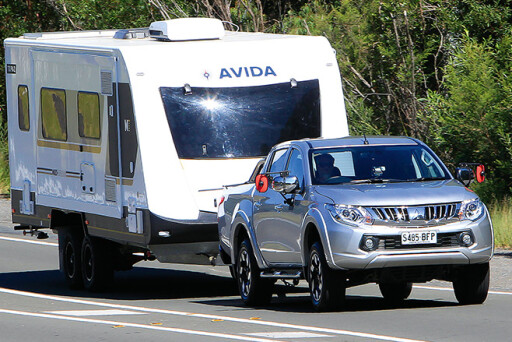 The Triton had the lowest towing capacity here of 3100kg (still an incredible amount to tow behind a vehicle without a special licence!) and was the vehicle that seemed to work the hardest. In the main, it took on its towing duties well, with no unsettling behavior. The Triton has the typical seven-pin set-up on its towbar and a clear, large reversing camera screen but no markers.
The Triton had the lowest towing capacity here of 3100kg (still an incredible amount to tow behind a vehicle without a special licence!) and was the vehicle that seemed to work the hardest. In the main, it took on its towing duties well, with no unsettling behavior. The Triton has the typical seven-pin set-up on its towbar and a clear, large reversing camera screen but no markers.
The Triton’s mirrors are the power-fold type and are too flexible and weakly sprung to be satisfactory with clip-on mirror use. In fact, in past tests, without the towing mirrors’ magnetic arm supports, both mirrors usually folded-in at speeds beyond 75km/h. With the supports on this time, the mirrors didn’t wilt but the vibration was such that the towing mirrors were shaking too much to be of much use beyond 80km/h.
On the road, the Triton’s 2.4-litre diesel has to work hard to keep the rig on the go in hilly terrain. It was mostly the slowest, and second-thirstiest of the bunch. Also like most of the others, it was noisy while doing so. It was acceptably quiet when cruisingand the transmission (full-time capable; the only one to offer this) was very smooth and subtle in its shifts. Like the others, the Sport mode doesn’t really work aggressively enough when towing such a heavy van, but the Triton has the bonus of having steering-mounted gear-shift paddles, which makes using manual mode easy. Its engine braking put the Triton in the mid-field here.
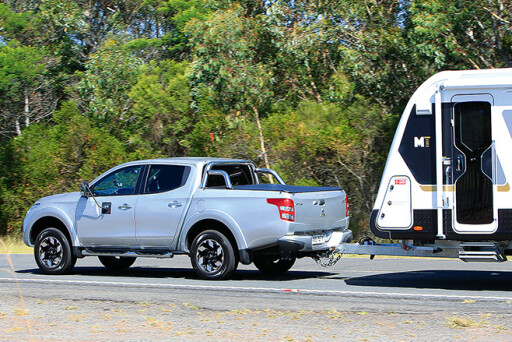 With the shortest wheelbase (3000mm) and by far the longest axle-to-towball distance (1550mm) on-paper the Triton is not as rock-solid stable as some others. The front rose 20mm with the load on and the rear drop was 65mm. However, the Triton wasn’t significantly affected by passing trucks and felt stable and confident cruising. However, it was the only vehicle here that triggered its Trailer Stability Assist (TSA): While negotiating a series of open 70km/h bends, the yawing motion (which felt rather benign at that speed) set off the TSA twice; probably due to the short wheelbase/long overhang compared to some others.
With the shortest wheelbase (3000mm) and by far the longest axle-to-towball distance (1550mm) on-paper the Triton is not as rock-solid stable as some others. The front rose 20mm with the load on and the rear drop was 65mm. However, the Triton wasn’t significantly affected by passing trucks and felt stable and confident cruising. However, it was the only vehicle here that triggered its Trailer Stability Assist (TSA): While negotiating a series of open 70km/h bends, the yawing motion (which felt rather benign at that speed) set off the TSA twice; probably due to the short wheelbase/long overhang compared to some others.
The body pitched noticeably over undulations (though not as much as the D-MAX) and the ride was quite sharp over bumps. While the Triton is quite quick when unladen, when towing it’s a different matter. When the relatively small displacement 2.4-litre was called on to lug nearly 5000kg, it trailed the field except for the hillclimb, where it just bettered the D-MAX. As a guideline, there’s no substitute for capacity when towing, and the Mitsubishi’s peak torque at a relatively high 2500rpm doesn’t help either.
SPECS
Engine: 2.4-litre 4cyl turbodiesel
Outputs: 133kW at 3500rpm/430Nm at 2500rpm
Transmission: Five-speed auto with manual mode
Driveline: Super Select II dual-range with full-time capability
Weight: 1875kg
Max towing capacity: 750kg (unbraked) 3100kg (braked)
Max towball download: 310kg
Fuel tank capacity: 75 litres
Price as tested: $47,790 (not incl on-road costs)
TOW TEST RESULTS
0-60km/h: 14.9sec
0-80km/h: 27.8sec
50-70km/h: 10.3sec
Hillclimb speed (start 100km/h): 69km/h
Descent speed (start 80km/h): 91km/h
Test average fuel consumption: 22.3L/100km
Towing range: (with 50km safety margin) 336km
WHAT WE RECKON
The Triton does the job. However, as our no-nonsense test regime demonstrates, it doesn’t quite have the same stout as others in its class. But with a middle-weight van (say, 2000kg laden) this would be a perfectly competent tow tug for an around-Oz trek, the bonus being Mitsubishi’s sharp prices.
NISSAN NAVARA ST-X
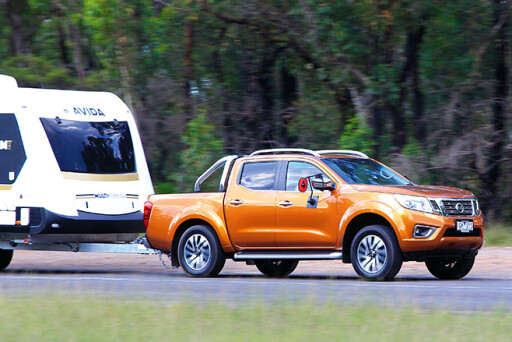 The Navara turned out to be a competent mid-fielder for towing heavy stuff, shouldering the load of a big, heavy van and 160kg of sand quite well.
The Navara turned out to be a competent mid-fielder for towing heavy stuff, shouldering the load of a big, heavy van and 160kg of sand quite well.
The Navara has a seven-pin plug as standard on its factory accessory towbar. The Nissan has a reversing camera with the screen incorporating a guidance line for coupling-up a trailer. The side mirrors are a tapered design that makes attaching towing mirrors awkward, but once they’re on they shake only a little. The Navara does not have trailer sway control in its stability control software.
On the road, the Navara’s engine is noisy when you dig deep for hills, but it’s very smooth and free-revving with a strong mid-range. The Nissan has the smallest displacement engine here (2298cc) but that doesn’t hurt fuel consumption; it’s the most fuel-efficient tow ute here, with the best touring range.
Helping the engine deliver its best is a seven-speed auto with sport and manual modes. The ratios are relatively tight and the shifts are smooth and decisive. The auto’s adaptive feature works the best of this group, offering quick kick-down shifts when needed and while not perfect, it makes a fair attempt at pegging descent speed with an assertive downshift.
The Nissan has a 3150mm wheelbase and 1350mm axle-to-towball measurement, both indications that it has good basic layout for towing. The front increased 20mm in height and the coil-sprung rear moved 65mm closer to the ground, putting the Navara towards the back of the pack for body attitude when taking on the weights involved here (160kg of sand and 280kg on the towball).
 The Navara feels relatively planted on the road, with only a small amount of yawing motion going on when we encountered the bluster of a truck on the freeway. The body’s fore-aft movement is on par with the Mitsubishi Triton, which means that an undulating section of road sets off a pitching motion that, while disconcerting, doesn’t upset steering or chassis dynamics. The Nissan’s performance makes it the exception to the no-substitute-for-cubic-inches rule: it only just trailed the Ranger and BT-50 and was ahead of the D-MAX, Triton and Hilux.
The Navara feels relatively planted on the road, with only a small amount of yawing motion going on when we encountered the bluster of a truck on the freeway. The body’s fore-aft movement is on par with the Mitsubishi Triton, which means that an undulating section of road sets off a pitching motion that, while disconcerting, doesn’t upset steering or chassis dynamics. The Nissan’s performance makes it the exception to the no-substitute-for-cubic-inches rule: it only just trailed the Ranger and BT-50 and was ahead of the D-MAX, Triton and Hilux.
SPECS
Engine: 2.3-litre 4cyl turbodiesel
Outputs: 140kW at 3750rpm/450Nm at 1500-2500rpm
Transmission: Seven-speed auto with Sport and Manual mode
Driveline: Part-time 4WD with high/low range
Weight: 1921kg
Max towing capacity: 750kg (unbraked) 3500kg (braked)
Max towball download: 350kg
Fuel tank capacity: 80 litres
Price as tested: $54,490 (not incl on-road costs)
TOW TEST RESULTS
0-60km/h: 13.0sec
0-80km/h: 22.2sec
50-70km/h: 8.0sec
Hillclimb speed (start 100km/h): 72km/h
Descent speed (start 80km/h): 90km/h
Test average fuel consumption: 18.1L/100km
Towing range: (with 50km safety margin) 392km
WHAT WE RECKON
We weren’t expecting the Navara’s coil-spring rear suspension (that in other testing has not coped well with a heavy load in the tray) to offer this level of stability. The small engine’s big heart was a surprise, too. Add the ratio-for-all-occasions seven-speed auto and the lightest fuel use here and the Navara is a good all-rounder.
ISUZU D-MAX LS-T
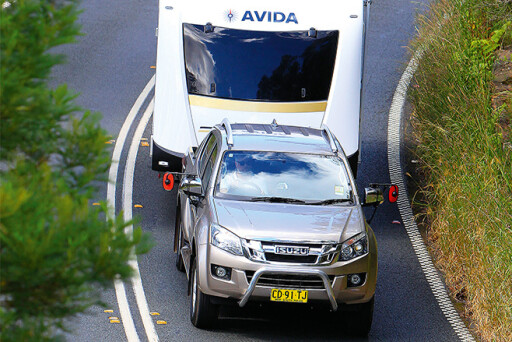 On paper, the D-MAX has the smallest output of this bunch but it does a good job of towing. The side mirrors were the best out of the six utes for securing towing mirrors, with only minor vibration.
On paper, the D-MAX has the smallest output of this bunch but it does a good job of towing. The side mirrors were the best out of the six utes for securing towing mirrors, with only minor vibration.
The Isuzu doesn’t have trailer-sway control as part of its chassis safety net and it comes with a seven-pin plug standard on its factory-option towbar. The Isuzu’s reversing camera doesn’t incorporate a marker line to assist with lining-up the hitch.
On the road, the D-MAX’s 3.0-litre engine is noisy when revved (which in hilly terrain, it’ll do a lot of) but it remains smooth. Things quieten down significantly at cruise. The transmission ratios are evenly spread in the lower gears, where stepping through the cogs counts for load lugging. Despite the regular need to draw deep into the Isuzu’s power, it was second to only the Nissan Navara in fuel use.
The transmission has a sequential shift manual mode but no sport mode. Instead, in D, it has an adaptive learning function that uses various inputs to better cater for driving style and conditions. Like others here, the transmission is smart enough to change gears in a more predictive manner when it’s dealing with just the vehicle, but doesn’t seem so bright when towing a heavy caravan.
The D-MAX works well in hilly terrain in manual mode, although its engine braking is not that flash compared to the others, the Isuzu sneaking to 95km/h down the test hill. With a 3095mm wheelbase and 1340mm axle-to-towball measurement, the Isuzu has a pretty good platform for towing. The front rose only 10mm with the load and van behind and the rear dropped 35mm over the axle, the least here.
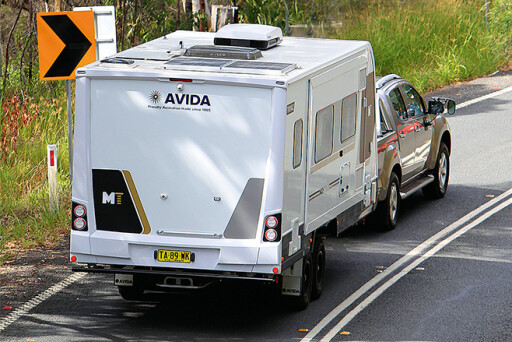 The Isuzu is stable with only a very slight yawing motion when large trucks pass. The Isuzu’s front end pitches significantly over undulations but otherwise the suspension does a good job of smoothing out road wrinkles.
The Isuzu is stable with only a very slight yawing motion when large trucks pass. The Isuzu’s front end pitches significantly over undulations but otherwise the suspension does a good job of smoothing out road wrinkles.
Although it has the lowest quoted peak torque of the six, the Isuzu is in the middle of this group for acceleration. Despite this, off-the-mark it’s the slowest and loses more speed during steep hill climbs than the others.
SPECS
Engine: 3.0-litre 4cyl turbodiesel
Outputs: 130kW at 3600rpm/380Nm at 1800-2800rpm
Transmission: Five-speed auto with manual mode
Driveline: Part-time 4WD with high/low range
Weight: 1940kg
Max towing capacity: 750kg (unbraked) 3500kg (braked)
Max towball download: 350kg
Fuel tank capacity: 76 litres
Price as tested: $53,000 (not incl on-road costs)
TOW TEST RESULTS
0-60km/h: 12.9sec
0-80km/h: 123.0sec
50-70km/h: 8.4sec
Hillclimb speed (start 100km/h): 68km/h
Descent speed (start 80km/h): 95km/h
Test average fuel consumption: 19.0L/100km
Towing range: (with 50km safety margin) 350km
WHAT WE RECKON
The Isuzu D-MAX is the jack of all trades and master of none here; it has a well-rounded heavy-hauling repertoire with good fuel economy but doesn’t hit the high notes for performance, ride or stability of the others above. Said another way, this is a no-nonsense rig that will do a great job, probably until you’re too old for caravanning.
Can these dual-cab utes tow a 3500kg trailer and 1000kg load in the tub? Find out here



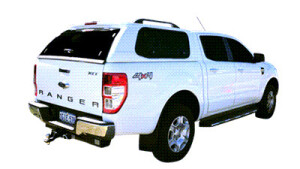
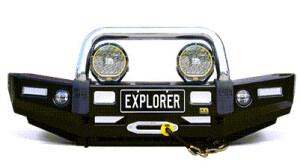


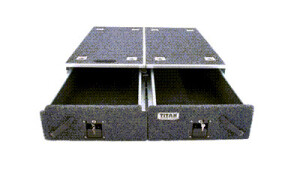
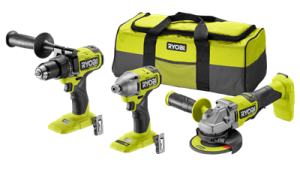
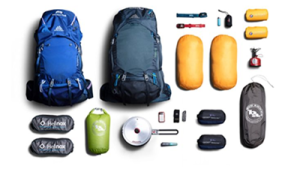

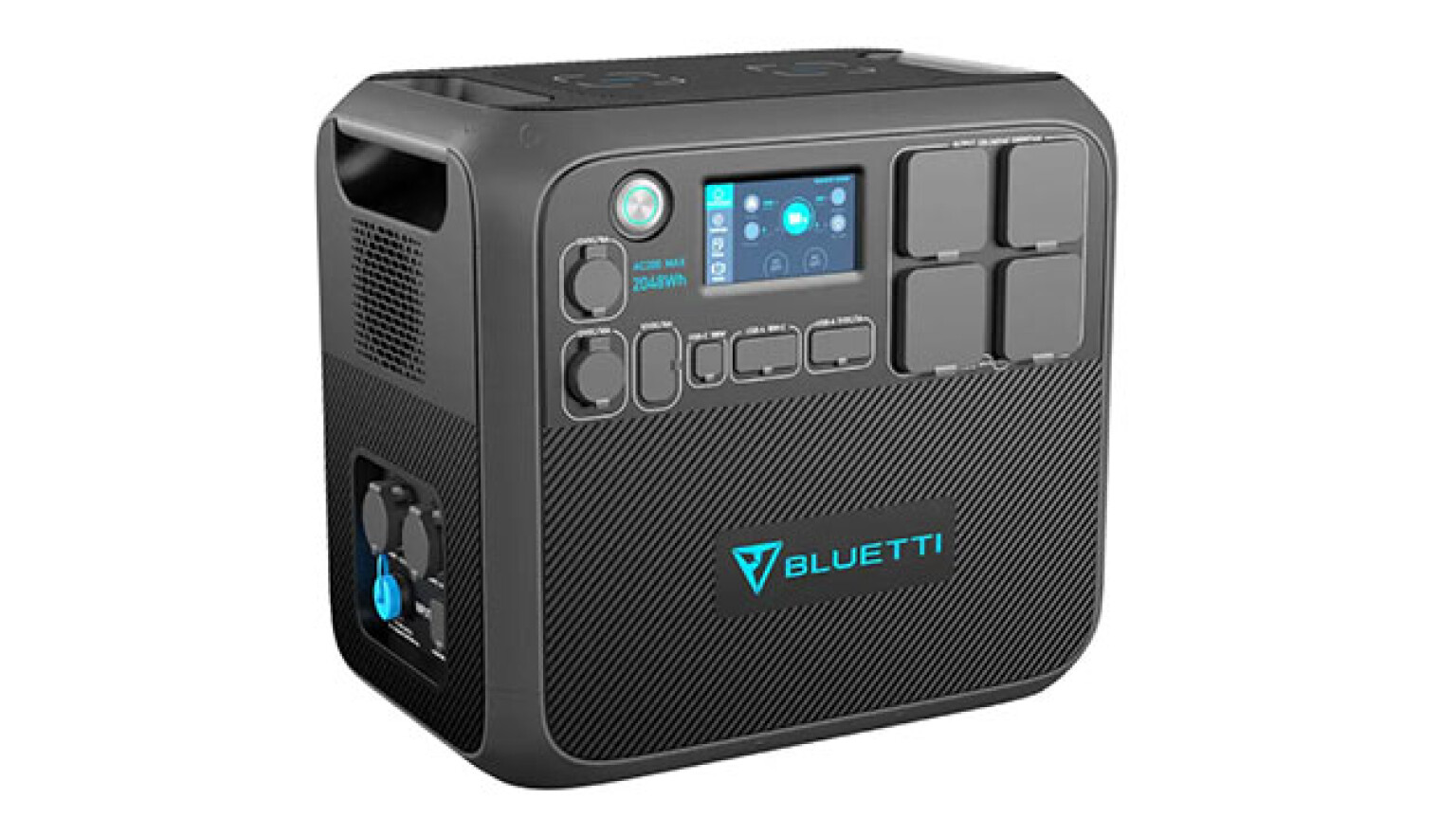
COMMENTS